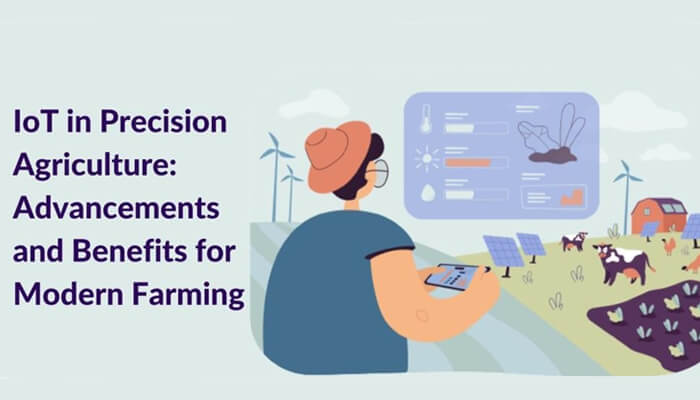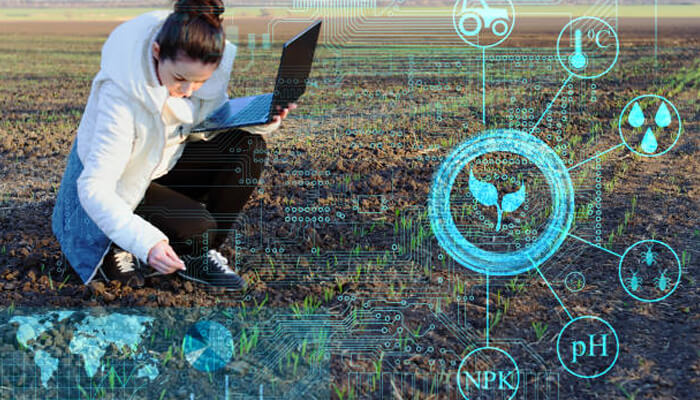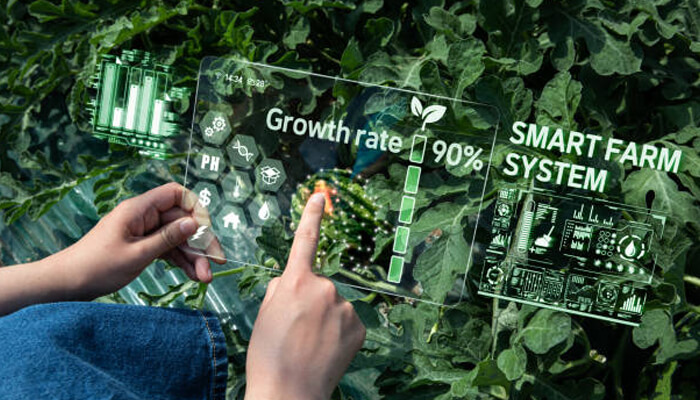The integration of IoT in precision agriculture has transformed the way farmers manage their land by providing them with real-time data on crop health, soil moisture, and weather conditions. Undoubtedly the adoption of IoT within the agriculture industry has allowed farmers to improve their productivity, profitability, and sustainability while meeting the growing demand for food in a rapidly changing world.
In this blog, we will explore the role of IoT in precision agriculture and how it is revolutionizing the way farmers manage their land. We will discuss the benefits of using IoT in precision agriculture, including increased efficiency, reduced costs, and improved crop quality. This blog will provide valuable insights into the exciting world of precision agriculture. So, let’s dive in and explore the role of IoT in transforming the future of farming.
But, before we move on further with the topic let us have a review about,
What is IoT Precision Agriculture and How is it Different from Traditional Agriculture?
Precision agriculture (PA) is a modern farming approach that uses advanced technologies and data analytics to improve the efficiency and productivity of agricultural practices. It involves the use of precision technologies to optimize and monitor various aspects of crop growth and management, such as soil health, nutrient management, irrigation, and pest control. With the advent of the Internet of Things (IoT), precision agriculture has been transformed by the integration of sensors, devices, and software that provide real-time data on crop health, soil moisture, and weather conditions.
In traditional agriculture, crops are often treated uniformly across large areas, which can lead to inefficient use of resources and lower crop yields. Precision agriculture, on the other hand, involves the use of sensors, data analytics, and other technologies to identify the unique needs of each individual plant or section of a field. This allows farmers to apply treatments and resources only where they are needed, maximizing yields and reducing waste.
Leveraging IoT development services has played a significant role in the transformation of precision agriculture. The IoT-enabled predictive analytics tools have allowed farmers to collect and analyze data on weather patterns, soil conditions, and other factors that affect crop growth. By applying machine learning algorithms to this data, farmers can predict crop yields, identify potential issues before they become problems, and adjust their operations accordingly.
What are the Different Types of IoT Devices and Sensors that are Used in Precision Agriculture?
IoT devices and sensors play a crucial role in precision agriculture by collecting real-time data on various aspects of crop growth and environmental conditions. The data collected by these devices and sensors is then analyzed to make informed decisions about irrigation, fertilization, pest control, and other agricultural practices. Here are some of the different types of IoT devices and sensors used in precision agriculture:
Soil Moisture Sensors
These sensors are used to measure soil moisture levels, allowing farmers to optimize irrigation and prevent overwatering. They can be placed directly in the soil or used in conjunction with weather sensors to determine the most efficient irrigation schedule.
Weather Sensors
It can measure temperature, humidity, wind speed, and other environmental factors that can affect crop growth. By collecting data on these factors, farmers can adjust their farming practices accordingly.
Crop Health Sensors
These sensors can measure the health of individual plants by detecting signs of disease, pests, and nutrient deficiencies. This allows farmers to detect problems early and take corrective action before they become serious issues.
GPS Trackers
It can be used to track the movement of farm equipment and livestock, allowing farmers to optimize their operations and improve efficiency.
Automated Irrigation Systems
It uses sensors to determine the precise water needs of crops and deliver water only where it is needed. This can help to conserve water and reduce costs while improving crop yields.
Drones
It can be used to collect aerial images of fields and crops, allowing farmers to identify areas that require additional resources or treatments. They can also be used to monitor crop growth and detect problems early.
Automated Weather Stations
It can collect real-time data on weather conditions, allowing farmers to adjust their farming practices accordingly. They can also be used to monitor soil moisture levels and other environmental factors.
Smart Sensors
It can be used to detect changes in environmental conditions and adjust farming practices accordingly. For example, they can be used to detect changes in temperature or humidity and adjust irrigation schedules accordingly.
Use Cases of IoT in Precision Agriculture
Soil Monitoring
Soil is one of the most crucial factors in crop production. IoT sensors can be used to collect data on soil temperature, moisture levels, and nutrient content. This information can then be used to make informed decisions about when to plant, fertilize, and irrigate.
Crop Monitoring
IoT sensors can be used to monitor crops in real-time, providing farmers with valuable insights into plant health, growth patterns, and stress factors. This data can be used to optimize crop production and reduce waste.
Water Management
Water is a precious resource, and farmers need to use it wisely. IoT sensors can be used to monitor water usage, identify leaks, and optimize irrigation schedules based on weather patterns and soil moisture levels.
Livestock Monitoring
IoT devices can be used to monitor livestock health, behavior, and location. This information can be used to prevent disease outbreaks, track animal movements, and optimize feeding schedules.
Benefits of IoT in Precision Agriculture
Increased Efficiency
The use of IoT in precision agriculture can help farmers optimize their operations and improve efficiency. IoT sensors can be used to monitor soil moisture, temperature, and nutrient levels, providing farmers with real-time data that they can use to make informed decisions about irrigation, fertilization, and other farming practices. This can help reduce waste and save valuable resources, leading to higher crop yields and greater profitability.
Better Crop Management
To implement IoT sensors for monitoring crop growth and development providing valuable insights into the health of their crops it is best to hire IoT developers. With this data, farmers can make informed decisions about planting, harvesting, and other farming practices, leading to optimized operations and improved crop yields. The expertise of an IoT developer is crucial in designing and implementing a customized IoT solution that meets the specific needs of the farm.
Improved Sustainability
The use of IoT in precision agriculture can help farmers reduce their environmental impact and improve sustainability. By collecting and analyzing data on soil moisture, temperature, and other environmental factors, farmers can make informed decisions about water and fertilizer use, reducing waste and minimizing the risk of environmental damage.
Enhanced Predictive Capabilities
IoT sensors can be used to collect data on weather patterns, pest infestations, and other factors that can impact crop yields. By analyzing this data, farmers can make informed decisions about when to plant, harvest, and take other actions to optimize their operations and improve yields. This can help farmers to anticipate potential issues and take action to prevent them, leading to higher yields and greater profitability.
Remote Monitoring
IoT sensors can be used to remotely monitor crops, soil, and other farming operations, providing farmers with real-time data and insights from anywhere in the world. This can be particularly useful for farmers who have multiple farms or who are unable to be always on-site, allowing them to monitor their operations and make informed decisions from afar.
Conclusion
The implementation of IoT technology in precision agriculture has provided significant benefits for farmers, including increased productivity, reduced costs, and more sustainable practices. However, the impact of IoT in precision agriculture goes beyond the farm level.
The data collected through IoT devices can be used to inform enterprise solutions that benefit the entire agricultural industry. For instance, companies can use the data to develop better crop insurance policies, inform commodity trading decisions, and optimize supply chain logistics.
By leveraging IoT in precision agriculture, stakeholders across the agricultural value chain can make better decisions, leading to more efficient and profitable operations. Overall, the integration of IoT technology in precision agriculture is not only transforming how farmers operate their businesses but also revolutionizing the industry.




